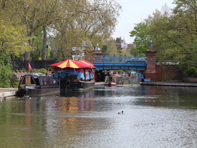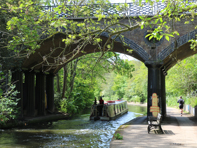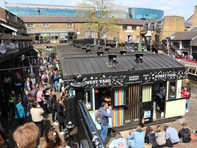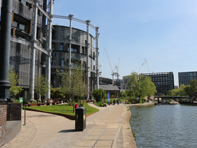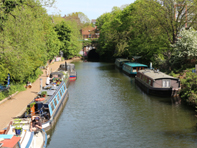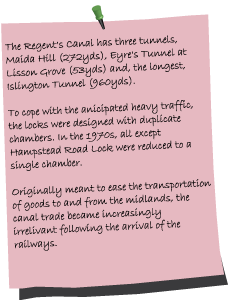
Originally proposed by businessman Thomas Homer and constructed between 1812 - 1820, the architect John Nash gained permission from the Prince Regent to use his name for a waterway that would connect the Grand Junction (now the Grand Union) canal at Paddington with the London docks at Limehouse.
8.6 miles long, the first section around the new Regent's Park between Little Venice and Camden Town was completed in 1816. The grand opening of the whole canal happened on 1 August 1820. Construction had been slowed by financial problems not the least Mr. Homer's fraudulent activities for which he was sentenced to be transported. The canal soon proved to be a success with Pickfords alone operating a fleet of over a hundred horse boats. However the London to Birmingham railway opened in 1838 and this faster form of transport attracted custom away from the canal. In fact the idea was floated more than once to turn the canal into a railway. Serious commercial use ceased after the transport of munitions was no longer required following the second world war but there was some traffic even into the 1970s.
Starting from Browning's Pool in Little Venice, private moorings stretch from Warwick Avenue Bridge to Maida Hill Tunnel. The walker has to go along Maida Avenue or Blomfield Road and then take an alley way from Aberdeen Place. Here you'll see the towpath below but it is again inaccessible as the canal enters Eyre's Tunnel. So continue to Lisson Grove and take another alley to the left of the cute Canal Office which straddles the water. This leads to Marylebone Wide and the attractive Lisson Grove Moorings. As you go under bridges carrying mainline trains to Marylebone, together with the Metropolitan and Jubilee underground lines, there is a tablet recording the fact that this was also the location of Lord's cricket ground.
Following Park Road Bridge there are a series of gleaming white residences high up on the far side of the cut, At first glance, or even on closer inspection, these appear to be John Nash originals. However they are Quinlan Terry's Regent's Park Villas, six large villas designed in the neo-classical style and built between 1988 - 2004. Regent's Park mosque can also be seen in the distance. Just a little further on, less salubrious living space has been established under Macclesfield Bridge otherwise known as 'Blow-Up Bridge'. It was here at 5.00am on the 2 October 1874 that a steam barge carrying explosives blew up and destroyed the structure, Great alarm was caused throughout north west London and there were hundreds of claims for the damage caused in the locality. Note that the supporting columns have rope grooves on both sides as they were turned around when the bridge was re-built.
The canal curves gently to dissect London Zoo, the most visible part of which is the walk-through Snowdon Aviary which has been 're-imagined' as Monkey Valley. There is a landing stage if you come by boat and attractive bridges connect the two parts of the zoo before the famous Feng Shang Princess floating Chinese restaurant comes into view where the canal turns sharply at the start of the former Cumberland Market Branch or Regent's Park Collateral Cut which ran for half a mile passing Regent's Park Barracks to Regent's Park Basin and Cumberland Market. The branch supplied emergency services with water during the blitz and was subsequently filled in using rubble from bombed out houses.
Camden Visitor Moorings are reached after Regent's Park Road Bridge and then the colourful Gilbey's Wharf. The gin firm was for a century a major Camden Town employer with a canal side distillery and bonded warehouses. The Pirate Castle is a community centre and following Southampton Bridge there is a further series of wharfs including Ice Well Wharf where wells were used to store frozen canal water which, unbelievably, was used for the catering trade. Camden Lock Market is now situated around Dingwall's Wharf (even though there is no Camden Lock). Developed in the 1970s as a craft market and subsequently gentrified, this area is normally rammed with tourists and Dingwall's Dance Hall, as it was originally called, has long been a renowned entertainment venue.
Before reaching the market you cross Dead Dog Bridge, reputed to be the busiest canal footbridge in the country, it's over the entrance to an underground basin below a former LNWR interchange warehouse. Next to the market is Hampstead Road Locks (even though they are next to Chalk Farm Road), the only remaining working double chamber lock on the canal. There's a wide expanse of water before Hawley Lock and then on the right before Kentish Town Lock, occupying a former brewery site, is the Breakfast Television Centre. Laden with egg cups, this was the home of TV-am, commercial television's first attempt at early morning broadcasting.
Kentish Town Wharf now boasts the rear of a large supermarket where the ABC bakery once stood and you won't know it but the River Fleet is crossed at Camden Bridge before you get to Camden Road Bridge. All the many wharfs in the area, Eagle, Pratt, Bangor etc. have been built over but at College or Lawford's Wharf there are still Grade II* workers' cottages rubbing shoulders with a more modern development. Following Grey's Inn Bridge, the area around Elm Village on the towpath side was once an expanse of Dickensian slums and then sidings for the Midland Railway, you pass Camden Eco-Moorings before the Oblique Bridge and St Pancras Railway Station Bridge over which the Eurostar glides.
You get a real sense now of how much the King's Cross area has been and continues to be developed and transformed from the railway age into something completely different. Sprawling marshalling yards are now shops, restaurants and offices including Gasholder Park opposite St Pancras Basin. You can see the station in the distance beyond a Victorian water tower designed by Gilbert Scott to serve locomotives, this was moved 600 yards when threatened by the Eurostar's new tracks and the gas holders have been re-located even further from their original site near Kings Cross station and three of them have been re-purposed as apartment blocks.
On the far side below St Pancras Lock there's Camley Street Natural Park which was formerly railway coal shoots. On the towpath side, Coal Drops Yard is a smart shopping mall. Then, turning the corner under Somers Town Bridge, the basin where grain was once offloaded for the Great Northern Railway has been filled in and imaginatively named Granary Square complete with a canalside astro-turf seating area, fountains and Central St Martins art school. The canal now traverses King's Cross Railway Aqueduct, this forms a winding hole where Word On The Water, the floating bookshop is situated.
Go under York Way and there's Kings Place at Battlebridge Basin. Battle Bridge is an ancient name for the area and the basin dates from 1825. This is the self-proclaimed 'cultural heart of King's Cross' and includes the Guardian's offices. The London Canal Museum occupies a building previously used to store ice from Norway for Mr Gatti, an ice cream merchant, no doubt preferable to the frozen canal water which was also used. As with similar moorings, only smokeless fuel can be used at Islington Eco-Moorings, note the artificial floating wetland to encourage bio-diversity and then the decorative Thornhill Bridge before reaching the western portal of the Islington Tunnel.

location information
